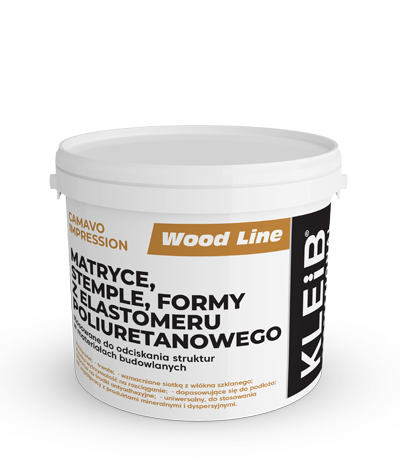MOULDS, STAMPS, POLYURETHANE ELASTOMER MOULDS
CAMAVO IMPRESSION is a polyurethane mould, a stamp for imprinting patterns in plasters and building putties. It is used for imprinting a certain structure, e.g. of wood grain, on fresh plasters or putties. This product is an element of CAMAVO system solutions. When combined with the CAMAVO CLS guide and spacing strip system and the CAMAVO ANTYSTICK release agent, it allows for imprinting eye-catching structures on the plaster. Easy horizontal and vertical working, on both flat and oval surfaces.
- resilient
- durable
- reinforced with fibreglass mesh
- high tensile strength
- adapts to the substrate
- resistant to release agents
- a versatile solution that can be used with mineral and dispersion products
INSTRUCTIONAL VIDEO:

CAMAVO IMPRESSION is a polyurethane die, a stamp for imprinting patterns in plaster and building putty. It is used when imprinting a specific structure, such as the grain of wood, in fresh plaster or putty. This product is part of CAMAVO's system solutions. In combination with CAMAVO CLS system strips and CAMAVO ANTYSTIC release agent, it enables attractive structures to be made in special plasters. It allows you to work freely both horizontally and vertically on both flat and oval surfaces.
CAMAVO IMPRESSION is perfectly suited for use when imprinting in mineral and dispersion materials such as adhesives, putties and mortars in the construction industry. Use fine-grained products recommended by the building chemistry manufacturers for such application (texturing). When trying it out yourself, make sure that the products used allow for a minimum application of 3-5 mm in one layer. The imprinting should only be started after skinning of the product on the surface. It should not stain your fingers when touched, while remaining soft in the mass.
Imprinting in the material should start with the layout of the areas that you want to obtain on a given plane. For example, in the case of a board imitation, it is most advantageous to select the width of the board so that the individual boards are approximately 0.5-1 cm narrower than the die used. When imprinting, the minimum thickness of the product applied for texturing should not be less than 3 mm. To do this, it is advisable to mark out the joint areas and to line the selected CAMAVO CLS strips with a thickness of 3 mm and above. The thickness of the strip should be chosen in such a way that the expected allowable thickness of a particular material at a time can be applied. Before gluing, the bonding points should be outlined on the surface. The selected plaster or filler should be applied with a trowel that allows it to be freely guided over a minimum of 2 laths at a time. The slats should be glued by removing the covering paper from the adhesive layer and immediately pressed to the substrate. Bonding should take place no more than 30 minutes before the material is applied. Application of the material should be along the strips. After the material has been applied, it is necessary to wait for the skinning of the product on the surface. Before using the matrix, lubricate the textured side of the matrix with the product recommended by the manufacturer of the construction chemical you are using. If there is none, use CAMAVO ANTYSTIC release agent. Lubrication should be repeated every 1 to 5 impressions, depending on the type of material in which you are imprinting. The imprinting is recommended to be carried out by 2 or 3 people. When working with two people, the die should be rolled with the textured side outwards and start imprinting from one side, unrolling and guiding the die with one edge along the strip. When unrolling, the matrix should be pressed evenly with a wallpaper roller. Alternatively, you can press down with your hand, but remember to keep your fingers together. When detaching the die from the substrate, it is important to remember to also 'roll' the die, rather than detaching the entire surface. After imprinting, remove the CAMAVO CLS strips. When using imprinting dies on mouldings after imprinting, the moulding should be separated from the material with a wallpaper knife, for example, before it has even set.
NOTES: After completion, the die should be washed with water and stored rolled up with the textured side out – as supplied in the packaging. Do not store the dies at high temperatures or in direct sunlight, as this may cause inappropriate deformation and yellowing of the dies (yellowing does not affect the quality of the die).
